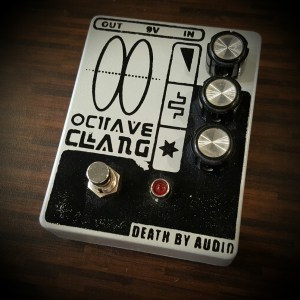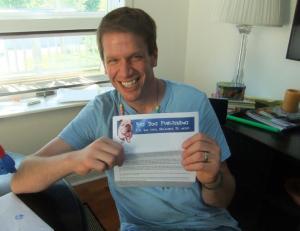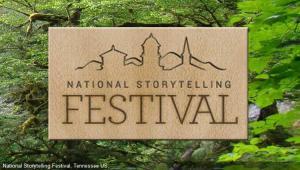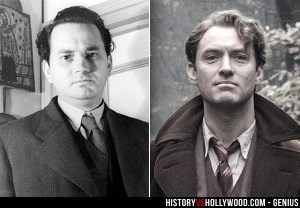Alex Bledsoe's Blog, page 7
March 20, 2017
Getting Down to the Story Quark
Recently, I had writer’s block.
Okay, I know what you’re thinking: he always says there’s no such thing as writer’s block! And that’s true. But what I experienced is the feeling often called writer’s block. And here’s how I addressed it.
This particular work-in-progress is a spec effort, so there’s no deadline or contract involved; at this point, I’m just writing it to see if the idea has legs. I quickly finished two chapters (chapter one ends on a killer cliffhanger), and have reached a point where the story, and the main character, need to skip ahead ten years.
 Which brings me to the problem. I have a vague idea where this is going, but I’m not working from an outline. I’ve done this enough to know that outlining ahead of time doesn’t make my writing faster, or more importantly, any better (your process may be different; the important thing is knowing what works best for you).
Which brings me to the problem. I have a vague idea where this is going, but I’m not working from an outline. I’ve done this enough to know that outlining ahead of time doesn’t make my writing faster, or more importantly, any better (your process may be different; the important thing is knowing what works best for you).
I’ve started chapter three probably five times, going off in five different directions, and each time written about 1,000 words before realizing this version won’t work, either.
I put each false start aside in a “scraps” file (you never can tell when you might need to raid something that didn’t, at first, seem to have any value), and got back to work. And I applied the approach I always recommend to students when they’re stuck: break it down until you have a piece so small you can move forward.
For example, if you don’t know what the next chapter should be, concentrate on the next scene.
If that doesn’t work, concentrate on the next paragraph.
Or the next sentence.
Or if you need it, just the next word.
My nine-year-old son is learning about subatomic particles in school, and like all kids, he has an incredibly inquisitive and logical mind about these things. He asks seriously, “What’s the smallest thing in the world?” Currently, the answer seems to be subatomic particles like quarks and electrons, although since we can’t actually see quarks, that may change. In the same way, the smallest particle of a story is the word; we have the individual letters, of course, but like quarks and electrons make up atoms, letters don’t have any narrative meaning until they make up words. So for that reason, a word is the smallest particle of your story.
So your story continues with your choice of the next word. And it’s a choice that, in the vast majority of cases, you can make. The important thing is to keep moving forward. Even one word is more than you had. And you never know when that one word will open the way to exactly what the story needs.
 Yes, you can do all this in your head, and if that’s your process, that’s fine. But many writers, like me, need to see that actual progress in front of them. They need proof that they’re accomplishing something, even if it’s just the tiniest possible thing. A story quark, if you will.
Yes, you can do all this in your head, and if that’s your process, that’s fine. But many writers, like me, need to see that actual progress in front of them. They need proof that they’re accomplishing something, even if it’s just the tiniest possible thing. A story quark, if you will.
So I stand by my assertion that, when writing is your job, writer’s block doesn’t exist. If you call an electrician, will he claim he can’t work because he has electrician’s block? Not likely, because it’s his job. And like any other job, some days will be easy, some incredibly hard. But either way, you show up, put in your hours, and keep moving forward.
Even if it’s only one story-quark at a time.
March 17, 2017
Guest post: the Strangest Guitar Modifications Out There
When I spoke with music writer, guitar teacher and session guitarist Natalie Wilson about doing a guest blog, I asked her to write about the strangest guitar modifications she’d run across. What she came up with was amazing; it always pays to ask an expert. So please, if you like it, leave Natalie a note in the comments.
###
If you like abstract music, you’re probably looking for ways to create the strangest guitar modifications out there. You’ve also probably realized that it could be difficult to find unique modifications that haven’t already been played countless times by other musicians. This can be discouraging, but thanks to technology, there are always new devices coming out that you can use to create the music that’s more bizarre than you could have ever imagined.
Let’s take a look at some of the strangest guitar modifications I’ve ever come across:
The Red Panda Raster Pedal
 This pedal will create eerie, abstract, and just plain weird sounds through delay and pitch-shifting settings. Not only will this pedal delay your audio like other delay pedals, but you can also adjust the settings to alter your pitch and essentially remove the tonality from your music. Additionally, this pedal has a Reverse Delay mode, which will play your audio back to you in reverse. For example, if you strum a chord, the weakest part of your chord will be played back first, and then the audio will progressively get stronger until you reach the initial strum. This will create a really interesting clipped sound.
This pedal will create eerie, abstract, and just plain weird sounds through delay and pitch-shifting settings. Not only will this pedal delay your audio like other delay pedals, but you can also adjust the settings to alter your pitch and essentially remove the tonality from your music. Additionally, this pedal has a Reverse Delay mode, which will play your audio back to you in reverse. For example, if you strum a chord, the weakest part of your chord will be played back first, and then the audio will progressively get stronger until you reach the initial strum. This will create a really interesting clipped sound.
You can hear the effects of this pedal by following this link.
The Red Panda Particle
 This pedal is a granular delay pedal, meaning the device will take your audio signal, cut it into small pieces, and then delay those pieces by different amounts of time depending on your setting. This pedal has a really blizzard setting called Freeze Mode. In this mode, the pedal will recycle the delay input instead of continuing to take in the live input. When your input drops below your threshold, your pedal will begin to read audio signals from your delay buffer. This will create a stutter effect which sounds really bizarre when you pair it with the pitch-shift setting. Your chop knob on your Particle pedal will set the threshold of when the pedal will start repeating itself rather than taking in new audio.
This pedal is a granular delay pedal, meaning the device will take your audio signal, cut it into small pieces, and then delay those pieces by different amounts of time depending on your setting. This pedal has a really blizzard setting called Freeze Mode. In this mode, the pedal will recycle the delay input instead of continuing to take in the live input. When your input drops below your threshold, your pedal will begin to read audio signals from your delay buffer. This will create a stutter effect which sounds really bizarre when you pair it with the pitch-shift setting. Your chop knob on your Particle pedal will set the threshold of when the pedal will start repeating itself rather than taking in new audio.
If you want to hear this setting in action, follow this link for a demo video.
Death by Audio Octave Clang
 This is another pedal that will give you the ability to create drone and fuzz sounds, making it a great fit for you if you’re interested in taking a traditional octave pedal to the next level. Octave pedals do what their name implies: they take your audio signal and produce octave accompaniment. This pedal will allow you to jump from effects that still maintain harmonic texture, all the way to a chaotic fuzz effect that dominates the natural tones of your instrument. The word “clang” should be taken literally since this pedal will create a lot of metallic and chaotic sound.
This is another pedal that will give you the ability to create drone and fuzz sounds, making it a great fit for you if you’re interested in taking a traditional octave pedal to the next level. Octave pedals do what their name implies: they take your audio signal and produce octave accompaniment. This pedal will allow you to jump from effects that still maintain harmonic texture, all the way to a chaotic fuzz effect that dominates the natural tones of your instrument. The word “clang” should be taken literally since this pedal will create a lot of metallic and chaotic sound.
If you think this pedal might be what you’re looking for, give it a listen by following this link.
Roland Funny Cat
 It’s kind of a given that a pedal called “Funny Cat” is going to have a bizarre sound. This is a vintage pedal from the 1970s and trust me, this pedal screams 1970s. This is a great pedal if you’re searching for the strangest guitar modifications with a vintage twist. The Funny Cat is a harmonic mover and a soft distortion tool that resembles a funky meowing cat (hence the name). The soft distortion setting will give you a regular distortion sound, but don’t be discouraged. Once you turn on the Harmonic Mover setting, you’ll hear what I’m talking about.
It’s kind of a given that a pedal called “Funny Cat” is going to have a bizarre sound. This is a vintage pedal from the 1970s and trust me, this pedal screams 1970s. This is a great pedal if you’re searching for the strangest guitar modifications with a vintage twist. The Funny Cat is a harmonic mover and a soft distortion tool that resembles a funky meowing cat (hence the name). The soft distortion setting will give you a regular distortion sound, but don’t be discouraged. Once you turn on the Harmonic Mover setting, you’ll hear what I’m talking about.
If you’d like to hear a demo of this pedal, follow this link.
Hopefully this article gave you some ideas about how to create the strangest guitar modifications possible. These devices will get you started, but remember: the strangest effects are the ones we haven’t even heard yet. So keep on experimenting and maybe you’ll be the next trendsetter in the world of obscure music.
###
 Natalie Wilson works as a professional musician, session guitarist, and guitar teacher. You can read more at her blog.
Natalie Wilson works as a professional musician, session guitarist, and guitar teacher. You can read more at her blog.
March 7, 2017
Interview: the Lucky Nows
The music in the Tufa novels comes from three main sources: classic folk music, modern indie music, and me. By that, I mean that if I can’t find lyrics to quote from in the first two sources, then it falls back on me to create them.
I’m under no delusions about being a songwriter, and I don’t necessarily consider my little snippets of lyrics to be actual songs; rather, they’re hints of songs, or if it’s not too twee, song spells designed to conjure the song in the reader’s imagination.
That’s always worked for me, until I got to the fifth Tufa novel, Gather Her Round. Without revealing any spoilers, a song has to perform a very specific plot function, and no matter how hard I looked, I couldn’t find an existing song that did the job. And when I tried writing it myself, I realized I was way out of my depth.
So it was time to get professional help.
Enter the Lucky Nows, Jen Cass and Eric Janetsky.
I’ve known Jen for over ten years. She’s smart, gorgeous, a real hero (she’s an Assistant Prosecuting Attorney) and a brilliant songwriter. Her husband Eric is a Juvenile Justice Specialist (also a hero) as well as a terrific musician and songwriter. Together, they took on the task of giving me a song that would a) do the job the plot requires, and b) actually be a good song.
They came up with “Against the Black.” And they were kind enough to talk about their songwriting process.
How challenging was writing this song?
 ERIC: “Against the Black” was not that difficult, really. Once we had the idea of how the song was going to be used and what it was going to be set against, it seemed to flow pretty effortlessly. Jen is such a great writer when it comes to lyrics that it was written as fast as she could put pen to paper. We agreed that it should be in a minor key and almost be similar to a dirge. A Celtic feel. I feel we accomplished that and we are very proud of the song.
ERIC: “Against the Black” was not that difficult, really. Once we had the idea of how the song was going to be used and what it was going to be set against, it seemed to flow pretty effortlessly. Jen is such a great writer when it comes to lyrics that it was written as fast as she could put pen to paper. We agreed that it should be in a minor key and almost be similar to a dirge. A Celtic feel. I feel we accomplished that and we are very proud of the song.
JEN: I’d love to be able to weave you an elaborate tale of two dedicated songwriters burning the midnight oil to carefully and meticulously craft the perfect song for this pivotal moment of Gather Her Round, but the truth is…it very nearly wrote itself.
I remember talking to you about the moment in the book the song would appear, and asking a few follow up questions to gain a better understanding of the emotional impact of the moment.
That is always what I try to get right as a songwriter…knowing the plot is important…but knowing the raw, brutal, naked and unadorned emotion that drives the moment is everything.
Once I could feel it…I could write it.
I allowed myself to feel Duncan’s jealousy and rage. I allowed him his weakness and his purposeful inaction. I felt his love and fear and helplessness. I could feel his broken desperation.
Then I put on my best Mandalay and let the night winds tell the tale…
What was the division of labor (i.e., who wrote the lyrics, who the music, etc.)?
ERIC: Jen wrote the lyrics and we collaborated on the chords and structure of the song. We actually wrote the song while sitting at our dining room table. Not all of our songs follow this process. I have to honestly say that Jen’s lyrics really drove the song…the feel, the melody, the tempo.
 JEN: In my heart of hearts I am a writer. I play guitar out of necessity, because we minstrels do. But ultimately, I’m telling a story, and everything I do is driven by the lyrics.
JEN: In my heart of hearts I am a writer. I play guitar out of necessity, because we minstrels do. But ultimately, I’m telling a story, and everything I do is driven by the lyrics.
Eric is a musician’s musician. His story is told through the chords he chooses and the notes he plays so beautifully over them. He can make you FEEL without a writing a single word.
“Against The Black” works so beautifully because we each used our unique strengths to tell a story together.
Does that make any sense?
Without Eric’s musical story, the words would just be words.
Without me finding a way to tap in and truly feel both Duncan and Mandalay, Eric’s music would not speak the way it does.
It was also a labor of true and complete love, because I’ve known this world and these characters for a very long time…and I very clearly remember sitting in Nashville meeting you for the first time and sharing your hope that these characters – this place – the Tufa – would find their way into the light. I loved these books when they were not yet books. I loved these characters when they were struggling to be born. So, or course, I loved to write for them and venture into their world for a song.
It was an honor to be some small part of this gorgeous, dangerous, haunting, magical world for a brief and beautiful moment.
Now that you’ve read the book, what do think about your song in that context?
ERIC: I love the context that the song was used. It is used in a very pivotal point of the story where secrets are unearthed and it connects a lot of pieces together. I love that Mandalay is singing the song directly to [character name redacted, because spoilers–A.B.] and it invokes this rage inside of him. It was incorporated directly into the story and I was not expecting that. I originally thinking it would be used more as a “score.” I was excited that Mandalay actually sang the song and it was, in my opinion, a very crucial scene of the book.
JEN: Mandalay is my spirit animal, so it was an incredible feeling to see my words coming from her and onto the pages of an Alex Bledsoe book.
And I had the benefit of hearing Eric’s music, our music, playing through Janet and Mandalay in my head, so I could truly fall into the scene and feel it envelop me completely.
We are so very honored to have been asked to write for Gather Her Round, and hope that we’ve done justice to this poignant moment, and these brilliantly flawed characters, with the words and music we chose.

Thanks to Jen and Eric for taking the time to talk to me about their process, and of course tremendous gratitude for writing “Against the Black” for Gather Her Round. The song will be included on the Lucky Now’s forthcoming album. And above and beyond all that, thanks for being such great friends.
March 1, 2017
Presenting Rex Winters: the Story behind Gather Her Round’s Dedication
Sometimes dedicating a book is easy, as when a particular person inspires you to write it in the first place, as Tia Sisk did for my first novel, The Sword-Edged Blonde. Or when they’re instrumental in the writing process, the way my son Jake was for Wake of the Bloody Angel. Or when the stars just align, as they did when my daughter came to live with us just as I was finishing He Drank, and Saw the Spider, a novel about a wayward princess who finds a new home.
Occasionally you dedicate books to famous people whose work has influenced you. My first seventies vampire novel, Blood Groove, was dedicated to the late Duncan Browne because I listened to his music incessantly while writing it. Its sequel, The Girls with Games of Blood, was dedicated to the late Laura Nyro, because a particular passage about her in another book was the germ for my story.
And then sometimes you do it just to acknowledge the ongoing friendship that makes being a writer so much more fun.

Playwright Steven Stack
My pal Steven Stack is a playwright who works in a very specific niche: he writes plays to be performed by middle schoolers and high school kids. They are funny, touching, and original; a recent one, Puberty is a Mime Field, is about a teen whose family all become mimes when they hit puberty. He also wrote a gender-swapped parody of Hamlet, Helga, and an Agatha Christie-style comedy called She Wrote, Then Died, Then Wrote Again. Ideas like this let him be both absurd, and deal seriously with things his chosen audience can appreciate. And his work resonates. He’s been performed all over the United States, as well as in India, Canada, and Japan.
I met Steven back when our oldest children attended the same preschool. He was a public school teacher then, and President Obama had just visited his class on his re-election campaign. We began meeting for coffee every Tuesday morning, talking about our current writing projects, our kids, movies, books, and anything else that interested us. We have daughters who were born a month apart, and our oldest children are in the same class at school.

Steven at my kitchen table with the acceptance letter for his second published play.
I can’t tell you how important it is for me to have a friend who’s also a stay-at-home dad, a writer and a transplanted Southerner. When he nods along with my complaints, I know that he really does “get it.” When he gives me comments on ideas, I know they’re solid and honest. The relationship has been a lifesaver more than once, particularly when dealing with career disappointment. I can only hope I’ve done as much for him.
(Of course, he also tells the story about how he beat me in pool, which caused me to have a heart attack. My version is that he beat me because I was about to have a heart attack. But I digress.)
And so, the dedication:
To Steven Stack, a.k.a Rex Winters.
(You’ll have to ask him about Rex Winters, though.)
February 27, 2017
Guest Post: The Story Spider’s First Festival
The new Tufa novel, Gather Her Round, begins on the stage of the National Storytelling Festival in Jonesborough, TN where twenty years ago I felt the first stirrings of what would become the Tufa. My friend Christi, a.k.a. professional storyteller Magda the Story Spider (above, onstage at the festival), was with me that first time, and she was kind enough to write a bit about her experience.

About 20 years ago, I heard of Jonesborough’s National Storytelling Festival for the first time. Surrounded by a group of bardic friends, we were all fascinated by the concept of an entire weekend of storytelling and oral tradition of all sorts and styles. There had to be something special about an event which tripled the size of a small town in upper East Tennessee every first weekend of October. Money was really tight as a student, but I scraped together enough pennies to carpool with my friend Alex and my adopted teenage sister Sarah. We were a trio of curiosity seekers ready for a spectacle.
We found ourselves in a well-organized circus, surrounded by huge white tents, taking over the small town square. Instead of lion tamers, acrobats, and clowns, these oversized marshmallows contained chairs for hundreds of listeners and a single stage where different tellers, armed with only a microphone, set a spell on each set of ears. We used the printed program as a treasure map, moving from site to site, seeking aural charms and prizes.

I was surprised by the sheer variety. Who knew how many ways a person could tell a tale? Some used just words, while other incorporated song and props and/or colorful costumes. Really, it was the words that captured all of us. Spoken syllables have a power that none of us can deny and when these professional storytellers spoke, a spell of silence bloomed, sending everyone to the edge of their rickety seats, clinging to that single ampiflied voice.
I learned more a few lessons during the weekend. The first was always know where your jacket and seat pillow are. It’s colder than you think when you spend an entire October weekend outside on metal chairs. The second was there are more Bledsoes in Jonesborough than all of Middle Tennessee. Mr. Alex’s family name seemed to be stenciled on businesses everywhere. Lastly, there is a power in these old tales. Whether was Sheila Kay Adams singing the old “love songs” that her Granny taught her or Andy Offutt Irwin reincarnating his Aunt Marguerite or Ed Stivender proving that a Northerner can spin a Jack tale just as thoroughly as anyone born below the Mason-Dixon line, everyone’s story is important.
Years later, when I went to graduate school, I went out of my way to take a storytelling class. I wanted to learn that magic for myself. I wanted to join the circus. Most of the other students were focused on children’s education, but it became very clear very quickly that these stories belonged to everyone. Stories are not just for children. Even during my own performances now, I find that parents tend to be even more interested in my words than their kids. There is as much enchantment in the words, “Once a upon a time…” as there is “That reminds me of…”. People of all ages know and value a good story when they hear and need it.
As humans, we speak in the language of story all the time- to our friends online, during our family nightly suppers, and even on televisions and movies. It shakes our memories, helping us remember people’s names. It gives us a deep biological tool, so we know in our guts what places and people are “safe”. It helps us communicate and connect with people we have never met. It gives us empathy with the rest of humanity.
So, when the NSF asked for submissions for their first ever Story Slam in 2012, you’d better believe I sent in a video. That October I was standing in one of those big white tents, on a single stage, armed with only microphone, facing hundreds of people in rickety seats. I didn’t win, but for five minutes, I got to be one of the circus magicians and I’ll never doubt the power of my own story ever again.
###
For the last eight years, Magda Underdown-DuBois has professionally performed stories in homes, bookstores, schools, festivals, and even farmers markets from North Carolina to West TN. In 2012, she was selected to performed in the Jonesborogh National Storytelling Festival’s 1st Annual Story Slam. She is a member of Explorastory, a Storytelling Guild based out of Hendersonville and an affiliate of the National Storytelling Network. You can find Magda the StorySpider aka C.M. Underdown-DuBois on Facebook, YouTube, Twitter, and Instagram.
February 3, 2017
How a Springsteen Bootleg Inspired a Scene in WISP OF A THING
Since today’s my birthday, I thought I’d bring y’all a little somethin’-somethin’: an example of how things end up the way they do in novels, along with an absolutely kick-ass song.
It used to be a lot of work being a Bruce Springsteen fan. He notoriously wrote many more songs than he put on his albums, and if you wanted to hear those, you had to track down bootlegs. And that was a total crap shoot; the sound quality of many (most?) were atrocious, and since they were illegal, you couldn’t complain. Occasionally you struck gold, as with Fire on the Fingertips, which was all unreleased songs, all of them completely mis-titled (see above), but containing two of my favorites, “Seaside Bar Song” and “Thundercrack” (on the jacket called “Get Your Wheels and Roll” and “Angel from the Inner Lake/Heart of a Ballerina”).
The greatest version of the hard-rocking “She’s the One,” better than the official one on the Born to Run album, better than any other live version I’ve heard, was one I first found on a bootleg. Recorded in 1976, it starts out as a slow version of Bo Diddley’s “Mona,” and then transitions into a section from Springsteen’s “Preacher’s Daughter,” before becoming the song we all know. And it’s so good, y’all, that I could accept the argument that this might be his greatest live track ever, except that I remember the twenty-minute explosion of “Tenth Avenue Freeze Out” on the 1999 reunion tour.
Still, I can’t tell you how many times I listened to a cassette of this version of “She’s the One” during the late 80s, when I worked for Olan Mills Portrait Studios tooling around Alabama, Mississippi and Florida in a Chevy with no air conditioner. Unfortunately, somehow I misplaced the album in those intervening years, and so the song became a vivid memory.
Now, we jump ahead fifteen years or so. While writing the second Tufa novel, Wisp of a Thing, I had my protagonist, Rob Quillen, play one of his own songs at the Tufa barn dance. In my head, and in a perfect world, there was no question what that song would be: that long-lost, blistering version of “She’s the One.” But of course I couldn’t use that song in the book, and even if I could, I’d never convey the sheer excitement of it. But I did structure my scene after that song, most obviously in the way Rob says “Wait a minute!” exactly the way Bruce does.
Like I said, I thought I’d never find that track again. But I reckoned not with the awesome power of the internet, and some idle surfing on YouTube last night actually turned it up. Here’s the Boss, just starting to really show what he, his band, and his songs could really do. And you’ll find, I hope, a tiny little piece of that excitement in chapter 16 of Wisp of a Thing.
January 29, 2017
The Two Sides of Every Heart a Doorway
In Seanan McGuire’s brilliant (and now award-winning) short novel Every Heart a Doorway, teens who’d once escaped reality to various fairytale realms find themselves back in our world, attending a special boarding school to help them re-acclimate to “reality.” They’re all desperate to return to those places where they felt accepted for who and what they were, and one of them wants this badly enough to kill.
In structure the story is a murder mystery, but in intent it’s about the way many of us simply don’t feel like we belong in this world. We wish for a doorway, or a portal, or a wardrobe, to take us to another place, where all the things that make us different are normal. McGuire, who can pretty much write anything she puts her cursor to, does a great job conveying the kids’ pain, which of course speaks to the inner teen in all of us. No teenager feels like they belong, and most feel like freaks of some kind. It’s the same universal truth that gives Harry Potter and the X-Men their dramatic power.
But I experienced an interesting dichotomy while reading it, one that ultimately has nothing to do with the author’s intentions. I certainly identified with the characters: I was as freakish as any teen, a nerdy bookworm with thick glasses, braces and bad skin, trapped in a redneck town long before social media. My parents, who grew up during the Depression, fell into that generation’s classic conundrum: they wanted their kids to have more than they ever did, but then they resented us for not properly “appreciating” it. They certainly had no time or sympathy for kids having trouble “fitting in.”
And yet I was also struck with powerful sympathy for the parents of these desperate children. Although none appear as characters, many are described: the parents of the protagonist, Nancy, believe she was traumatized by a kidnapping, rather than escaping to the Underworld to willingly serve the Lord of the Dead. Their clueless attempts to reintegrate her into society are presented as well-meaning but disastrous, and the failure of all the parents to believe what had really happened to their children is shown as a great tragedy.
(I should clarify that this has nothing to do with the sexuality or gender identity aspects of the story. That’s an issue whose reality is beyond dispute. People are who they feel they are, no matter what anyone else, parents included, tries to make them.)
The symbolism is plain: the real world wants us to give up our childhood belief in “magic,” and that’s a terrible thing. But is it?
I’m a parent now, of three children blessed/cursed with intelligence and vivid imaginations. One in particular is likely to never “fit in.” And yet I can’t really believe that the best course for him is to totally indulge his fantasies; isn’t part of my job description to prepare him for the world as best I can? And isn’t part of that giving up belief in the childish forms of “magic”?
Or, as Bruce Springsteen says in the song, “Two Hearts”:
Once I spent my time playing tough-guy scenes
But I was living in a world of childish dreams
Some day these childish dreams must end
To become a man and grow up to dream again
That’s a paraphrase of 1 Corinthians 13:11:
When I was a child, I spake as a child, I understood as a child, I thought as a child: but when I became a man, I put away childish things.
But the Boss goes the Bible one better* by insisting that you grow up to dream again.
To me, that’s the job of a parent: to guide your children to the point that they willingly give up their childhood magic, and embrace the magic to be found in adulthood. And there is magic in it: when you see your newborn child for the first time, it casts a greater spell than any storybook realm. And when you take your love for childish scribbling and develop it into the adult skill of writing stories and novels (such as Every Heart a Doorway), that’s a charm that can affect millions.
And yet.
The memory of my parents telling me that people bullying me was my own fault for being “weird” is, to this day, never far from the surface. I vividly recall their insistence that my cousin Rob, who picked on me mercilessly for reading science fiction, was just being “normal.” I often wonder what kind of person I’d be today if they’d had the least bit of empathy, or stood up for me against the extended family instead of shaking their heads along with them, just like the unseen parents in Every Heart a Doorway. Or if, like the kids in the book, I’d found another realm where I was accepted as I was, where “weird” was the norm.
It’s the brilliance of this book that it allows the reader to embrace these contradictory feelings without giving any easy or facile answers. Ultimately, if there is an answer, I suppose it’s this: children need guidance, and parents need sensitivity. The ratio is different for every family, but when they’re out of balance, you get real, lasting and permanent damage.
*You have no idea how much it delighted me to write this phrase.
January 26, 2017
The Idiocies of Genius
Recently I watched Genius, the 2016 film about the relationship between Southern novelist Thomas Wolfe (Jude Law) and his editor, Maxwell Perkins (Colin Firth). There are also cameos by F. Scott Fitzgerald (Guy Pearce) and Ernest Hemingway (Dominic West). The moral of the story: genius comes in different packages, and sometimes it isn’t recognized until it’s too late. Or something.
I knew the name Maxwell Perkins, and of course had encountered Wolfe in my Southern Lit classes back in college. I was particularly surprised at how much of the film’s run time was concerned with the actual mechanics of getting a manuscript ready. But overall I was both underwhelmed by the movie, and curious about the real Perkins. So I picked up Max Perkins, Editor of Genius by A. Scott Berg, the source for the film.
And once again I ran into the great truth about movies: they are often made by people who, because they’ve spent their whole lives watching and doing nothing but movies, can only translate fascinating real life into the same tired tropes they’ve seen in other films. Genius leaves out virtually all the really interesting details about Wolfe’s relationship with Perkins, and replaces them with trite scenes you’ll find in virtually every biopic, regardless of topic.

The real Thomas Wolfe (l) and actor Jude Law portraying him. Note that the camera has to look up at the real Wolfe because of his extreme height.
To begin with, let’s talk casting. Whatever else he was, Thomas Wolfe was physically huge. At a time when average men were 5’8”, he was 6’6”. He dominated any room, and had difficulty with doors and vehicles being too small. Yet in the film, he’s portrayed by Jude Law, who is of average height and size. Worse, he’s cast opposite an actor (Firth) who’s actually taller (see the image in the poster above). So right away, one unique and fascinating aspect of his character—this enormous North Carolina hillbilly careening through pre-Depression New York City—is gone, replaced by a pretty British actor whose Southern accent is straight out of Steel Magnolias (not a compliment), and who performs with all the subtlety of Dennis Quaid playing Jerry Lee Lewis.
Colin Firth as Perkins is essentially fine, since the character is well within his range and his American accent is less specific than Wolfe’s. But again, fascinating details found in the book are left out. For example, Perkins had a custom-made standing work desk decades before such things were common, yet you won’t find it in the movie; he’s shown in a typical office, where he works like an accountant. And the list of famous authors he discovered began before Wolfe, and continued afterward; it’s only movie-think that implies that after Wolfe, Perkins essentially did nothing notable.
Worse are the moments invented for the movie that simply aren’t true. In one scene, Wolfe’s married lover (Nicole Kidman) pulls a gun on Perkins; this was mentioned as a veiled threat in a letter, but didn’t actually occur. Toward the end, Wolfe visits F. Scott Fitzgerald in Hollywood, where the scribe of the Jazz Age tells Wolfe that Perkins has “a genius for friendship,” thereby making the title ironic (italics mine, but thoroughly implied by the movie). This visit is never mentioned in the book, and functions merely as the final reckoning before the onslaught of the illness that killed Wolfe (and did not involve collapsing on a Hollywood beach).
Why does all this annoy me so much? I mean, no one looks to movies for actual history, right? It’s because in so many ways, this is typical of what happens to true stories in the movies: filmmakers assume that something they’ve seen in another movie is somehow better than the actual truth, which is often quirky and original and very, very cinematic. And these movies then become the history, at least in most people’s minds.
Still, even though (again) there’s no real documentary evidence to back it up, I have to praise the depiction of the actual editorial work involved in revising Look Homeward, Angel and Of Time and the River. Perkins never tells Wolfe what to write, he merely guides his thought process in a way that lets the author come up with the solution. When he advocates cuts (necessary since the movie is accurate about the Brobingdangian size of Wolfe’s original manuscripts), he explains why, and his reasons always have to do with story, not marketing concerns or the practicalities of printing. Wolfe, for his part, is shown resisting these suggestions at first, then finally coming around and providing revisions, often on the spot. This, in my experience, is very true to life, in a job that hasn’t substantially changed since then.
So overall, Genius infuriated me. It was about things that I know well: Southernness, book writing, and the editorial process. It only got the last of those things right.
You can find another, more detailed history-to-film comparison here.
January 21, 2017
Found! The Scariest Sound of My Childhood
I love the idea of Bigfoot. Who doesn’t wish that a huge, mostly-human monster lived at the edges of our civilization, only occasionally glimpsed and even less often photographed? I’ve read tons of books on the subject, and even wrote a draft of a novel about them back in the 90s. But my interest in them goes back even further, to a movie, and a sound.
Back in the early 70s, when I was about nine or ten, I talked my dad into taking me to a movie, although I’ve since forgotten which one. Unlike now, when all you get are commercials, back then you would occasionally get an actual short film before the main feature, and on this night, that short film was about Bigfoot. And it included what the film claimed was an actual Bigfoot cry.
(This might be a sound byte from the actual film; I don’t know. But that is definitely the same Bigfoot call.)
This was, and remains, the scariest sound I’ve ever heard, and even sitting there in that crowded theater, I was terrified. I was so scared, in fact, that I reached over and grabbed my dad’s hand, which probably freaked him out as much as the scream did me.
From then on, I was hooked.
Since then, what was once my niche interest has become unavoidably mainstream. Since the Discovery network and its associated channels (History, Animal Planet, Destination America, et. al.) have essentially abandoned actual science, we now have shows like Finding Bigfoot (which really should be called Never Finding Bigfoot, because these idiots are never going to find anything but their own asses), Mountain Monsters, Killing Bigfoot and even Spike TV’s Ten Million Dollar Bigfoot Bounty. Everyone knows, or thinks they know, all about Bigfoot.
But what do we actually know? Remember, to refute the statement, “All crows are black,” you only need one white crow; similarly, to prove Bigfoot exists, you only need one piece of evidence that can’t be explained in any other way. Unfortunately, we don’t have that Bigfoot-related white crow. We have footprints (that could be faked), photos and video (that, especially now, could be faked) and anecdotal evidence of encounters (notoriously unreliable, if not outright fakes).
So I don’t “believe” in Bigfoot; as I said, I believe in the idea of Bigfoot, the possibility. There’s enough uncharted wilderness that a creature who is rare, shy, and smart might exist and only rarely interact with people. But the longer we go without a clear picture or video, especially now that everyone has access to the technology, the less likely it seems. And even then, until we have a carcass, or at least DNA, there are people who (rightly) won’t be convinced. And I’m one of them.
But damn, that Bigfoot call still gives me the willies.
January 20, 2017
Favorite Story Song contest
Popular music has stopped telling us stories.
The story song used to be a staple of pop, occasionally rock, certainly country. But since the advent of “singers” enslaved to Auto-Tune and “songwriting” done by marketing committee (not to mention the whole “bro-country” movement), the story song (along with other forms of good music) has vanished from the mainstream airwaves.*
Yet there’s a need for those, not least because I have to sing something to my daughter at bedtime. Currently she loves Jim Croce’s “You Don’t Mess Around with Jim,” and Springsteen’s “From Small Things (Big Things One Day Come).”
So in the comments below, tell me your favorite story song, and why it speaks to you. You’ll be entered to win one of three advance reader copies of the upcoming fifth Tufa novel, Gather Her Round. The deadline is midnight Sunday, January 29th. Assuming we haven’t been destroyed in a nuclear war by then.
*I’m not one of those cranky old-timers who says there’s no good new music. There’s tons of it. You just won’t hear it on the radio.



